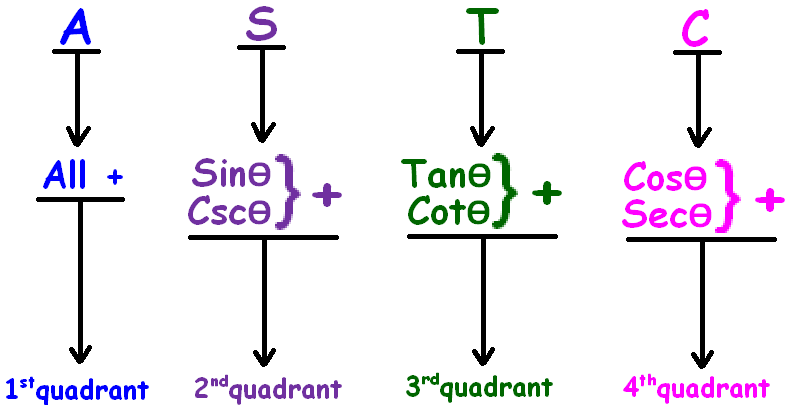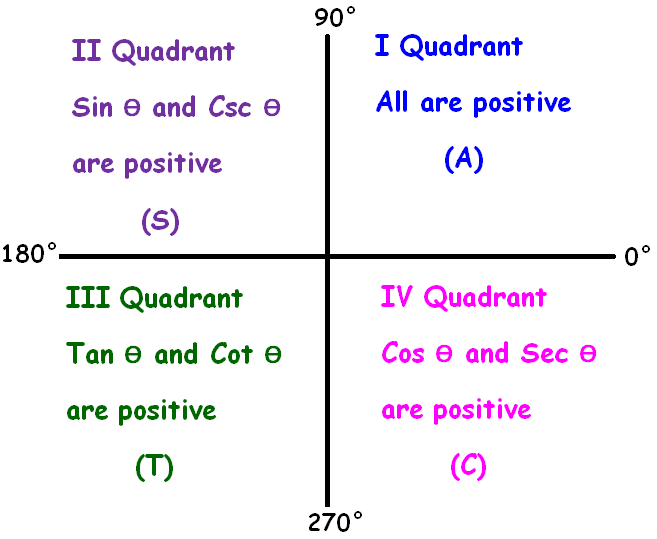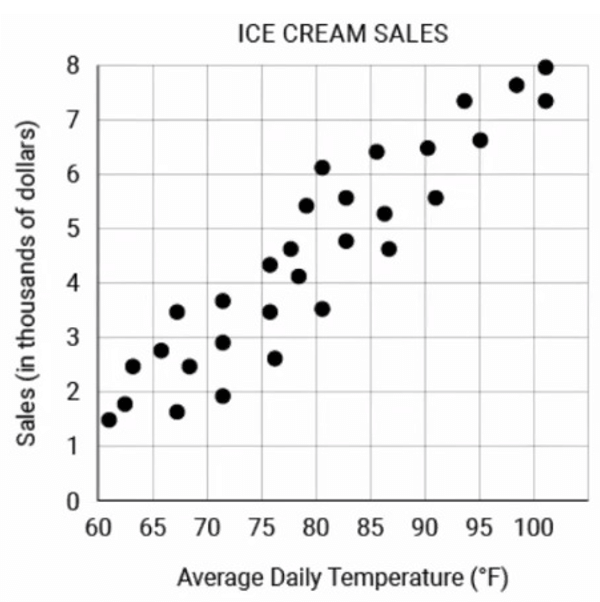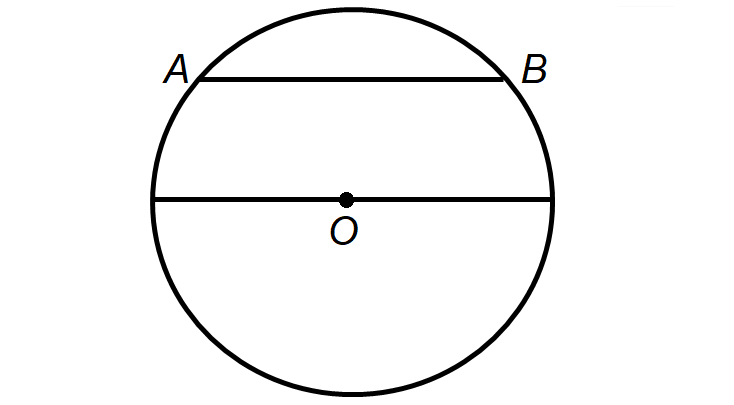ALL SIN TAN COS Rule
The "all sin tan cos rule" can be remembered easily using the following phrases.
"All Sliver Tea Cups"
or
"All Students Take Calculus"
or
"All Students Take Coffee"
"All Sin Tan Cos rule" is also known as ASTC formula in trigonometry.
ASTC formla has been explained clearly in the figure given below.

More clearly,

In the first quadrant (0° to 90°), all trigonometric ratios are positive.
In the second quadrant (90° to 180°), sin and csc are positive and other trigonometric ratios are negative.
In the third quadrant (180° to 270°), tan and cot are positive and other trigonometric ratios are negative.
In the fourth quadrant (270° to 360°), cos and sec are positive and other trigonometric ratios are negative.
Important Conversions
When we have the angles 90° and 270° in the trigonometric ratios in the form of
(90° + θ)
(90° - θ)
(270° + θ)
(270° - θ)
We have to do the following conversions,
sin θ <------> cos θ
tan θ <------> cot θ
csc θ <------> sec θ
For example,
sin (270° + θ) = - cos θ
cos (90° - θ) = sin θ
For the angles 0° or 360° and 180°, we should not make the above conversions.
Division of Quadrants
(90° - θ) -------> I st Quadrant
(90° + θ) and (180° - θ) -------> II nd Quadrant
(180° + θ) and (270° - θ) -------> III rd Quadrant
(270° + θ), (360° - θ) and (- θ) -------> IV th Quadrant
All Sin Tan Cos Rule - Practice Questions
Question 1 :
Evaluate : cos (270° - θ)
Answer :
To evaluate cos (270° - θ), we have to consider the following important points.
(i) (270° - θ) will fall in the III rd quadrant.
(ii) When we have 270°, "cos" will become "sin"
(iii) In the III rd quadrant, the sign of "cos" is negative.
Considering the above points, we have
cos (270° - θ) = - sin θ
Question 2 :
Evaluate : sin (180° + θ)
Answer :
To evaluate sin (180° + θ), we have to consider the following important points.
(i) (180° + θ) will fall in the III rd quadrant.
(ii) When we have 180°, "sin" will not be changed
(iii) In the III rd quadrant, the sign of "sin" is negative.
Considering the above points, we have
sin (180° + θ) = - sin θ
Based on the above two examples, we can evaluate the following trigonometric ratios.
|
sin (-θ) = - sin θ cos (-θ) = cos θ tan (-θ) = - tan θ csc (-θ) = - csc θ sec (-θ) = sec θ cot (-θ) = - cot θ sin (90°-θ) = cos θ cos (90°-θ) = sin θ tan (90°-θ) = cot θ csc (90°-θ) = sec θ sec (90°-θ) = csc θ cot (90°-θ) = tan θ sin (90°+θ) = cos θ cos (90°+θ) = -sin θ tan (90°+θ) = -cot θ csc (90°+θ) = sec θ sec (90°+θ) = -csc θ cot (90°+θ) = -tan θ sin (180°-θ) = sin θ cos (180°-θ) = -cos θ tan (180°-θ) = -tan θ |
csc (180°-θ) = csc θ sec (180°-θ) = -sec θ cot (180°-θ) = -cot θ sin (180°+θ) = -sin θ cos (180°+θ) = -cos θ tan (180°+θ) = tan θ csc (180°+θ) = -csc θ sec (180°+θ) = -sec θ csc (180°+θ) = cot θ sin (270°-θ) = -cos θ cos (270°-θ) = -sin θ tan (270°-θ) = cot θ csc (270°-θ) = -sec θ sec (270°-θ) = -csc θ cot (270°-θ) = tan θ sin (270°+θ) = -cos θ cos (270°+θ) = sin θ tan (270°+θ) = -cot θ csc (270°+θ) = -sec θ sec (270°+θ) = cos θ cot (270°+θ) = -tan θ |
Angles Greater than or Equal to 360°
If the angle is equal to or greater than 360°, we have to divide the given angle by 360 and take the remainder.
For example,
(i) Let us consider the angle 450°.
When we divide 450° by 360, we get the remainder 90°.
Therefore, 450° = 90°
(ii) Let us consider the angle 360°
When we divide 360° by 360, we get the remainder 0°.
Therefore, 360° = 0°
Based on the above two examples, we can evaluate the following trigonometric ratios.
sin (360° - θ) = sin (0° - θ) = sin (- θ) = - sin θ
cos (360° - θ) = cos (0° - θ) = cos (- θ) = cos θ
tan (360° - θ) = tan (0° - θ) = tan (- θ) = - tan θ
csc (360° - θ) = csc (0° - θ) = csc (- θ) = - csc θ
sec (360° - θ) = sec (0° - θ) = sec (- θ) = sec θ
cot (360° - θ) = cot (0° - θ) = cot (- θ) = - cot θ
Trigonometric Ratios of Angles Greater than or Equal to 360° - Practice Problems
Problem 1 :
Evaluate :
tan 735°
Solution :
The given 735° is greater than 360°.
So, we have to divide 735° by 360 and take the remainder.
When 735° is divided by 360, the remainder is 15°.
Therefore,
735° = 15° ------> tan 735° = tan 15°
Hence, tan 735° is equal to tan 15°.
Problem 2 :
Evaluate :
cos (-870°)
Solution :
Since the given angle (-870°) has negative sign, we have to assume it falls in the fourth quadrant.
In the fourth quadrant, "cos" is positive.
So, we have cos (-870°) = cos 870°.
The given 870° is greater than 360°.
So, we have to divide 870° by 360 and take the remainder.
When 870° is divided by 360, the remainder is 150°.
Therefore,
870° = 150° ------> cos 870° = cos 150°
cos 870° = cos (180° - 30°)
cos 870° = - cos 30°
cos 870 = - √3 / 2
Hence, cos 870° is equal to - √3/2.
Problem 3 :
Find the value of :
(sin 780 sin 480° + cos 120° cos 60°)
Solution :
Let us find the value of each trigonometric ratio for the given angle.
sin 780° = sin 60° = √3 / 2
sin 480° = sin 120° = sin (180° - 60°) = sin 60° = √3/2
cos 120° = cos (180° - 60°) = - cos 60° = - 1/2
cos 60° = 1/2
sin780 sin480° + cos120° cos60° is
= (√3/2) x (√3/2) + (-1/2) x (1/2)
= (3/4) - (1/4)
= (3-1) / 4
= 2 / 4
= 1/2
Hence, the value of the given trigonometric expression is equal to 1/2.
Problem 4 :
Simplify :
cot (90°-θ) sin (180°+θ) sec(360°-θ) / tan(180°+θ) sec(-θ) cos(90°+θ)
Solution :
Using ASTC formula, we have
cot (90°-θ) = tan θ
sin (180°+θ) = - sin θ
sec(360°-θ) = sec θ
tan(180°+θ) = tan θ
sec(-θ) = sec θ
cos(90°+θ) = - sin θ
Then, the given expression is
= (tan θ x -sinθ x sec θ) / (tan θ x sec θ x -sin θ)
= 1
Hence, the simplification of the given trigonometric expression is equal to 1.
Problem 5 :
Simplify :
sec(360°-θ) tan(180°-θ) + cot(90°+θ) csc(270°-θ)
Solution :
Using ASTC formula, we have
sec (360°-θ) = sec θ
tan (180°-θ) = - tan θ
cot (90°+θ) = - tan θ
csc (270°-θ) = - sec θ
Then, the given expression is
= sec θ x (-tan θ) + (-tan θ) x (-sec θ)
= - sec θ x tan θ + sec θ x tan θ
= 0
Hence, the simplification of the given trigonometric expression is equal to 0.
Kindly mail your feedback to v4formath@gmail.com
We always appreciate your feedback.
©All rights reserved. onlinemath4all.com
Recent Articles
-
Digital SAT Math Problems and Solutions (Part - 72)
Nov 23, 24 09:36 PM
Digital SAT Math Problems and Solutions (Part - 72) -
SAT Math Resources (Videos, Concepts, Worksheets and More)
Nov 23, 24 10:01 AM
SAT Math Resources (Videos, Concepts, Worksheets and More) -
Digital SAT Math Problems and Solutions (Part - 76)
Nov 23, 24 09:45 AM
Digital SAT Math Problems and Solutions (Part - 76)

